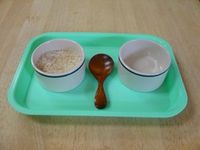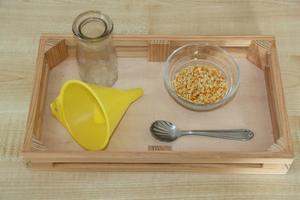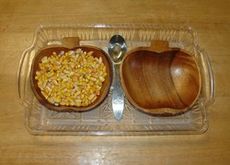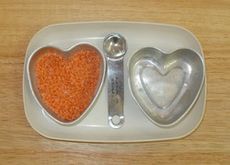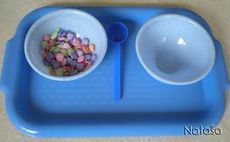Dry Spooning: Difference between revisions
From Montessori Album
No edit summary |
No edit summary |
||
| Line 41: | Line 41: | ||
== Further Reading == | == Further Reading == | ||
*[[Teach Me to Do It Myself]] by Maja Pitamic, pages 28-29 | *[[Teach Me to Do It Myself]] by Maja Pitamic, pages 28-29 | ||
{{#seo: | |||
|title=Dry Spooning | |||
|title_mode=replace | |||
|keywords=Montessori Album,lesson,activity,practical life,Fine Motor Skills,Dry Spooning | |||
|description=The purpose of this activity to teach the child how to transfer dry materials with a spoon. | |||
|published_time={{REVISIONYEAR}}-{{REVISIONMONTH}}-{{REVISIONDAY2}} | |||
}} | |||
Revision as of 17:57, 4 June 2020
| Dry Spooning | |
|---|---|
| Practical Life - Fine Motor Skills | |
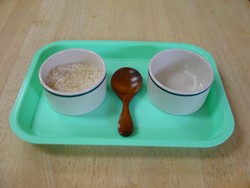 | |
| Level | Primary |
| Age | 2.5+ |
| Materials | 2 bowls spoon uncooked rice tray |
The purpose of this activity is to teach the child how to transfer dry materials with a spoon. This activity also helps prepare the child to eat independently.
Presentation
- Carry the tray to a table. Be sure that the full bowl is on the left.
- step two
- step three
Points of Interest
- Carrying the grain across
Control of Error
- The grain that is spilled (It helps if the tray is a contrasting color, so that the grain in easier to see.)
Variations and Extensions
Variations
- Different sizes of spoons could be used.
- Different shapes of bowls could be used.
- Instead of dry rice, dry beans, sand, small pasta, seeds, whole spices, or beads could be used.
Extensions
- The work could be done with a funnel and a narrow bottle:
- Source:Counting Coconuts
Material
- From Leptir Montessori Blog:
Further Reading
- Teach Me to Do It Myself by Maja Pitamic, pages 28-29
